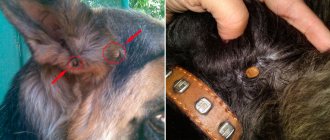10/22/2018 Category: Ticks Author: Svetlana Vladimirova
There are many varieties of ticks, but Ixodid ticks are the most dangerous of them all. These insects suck blood and, as a result, are carriers of dangerous diseases. If a cat has been bitten by a tick, then urgent measures must be taken to protect the pet from a number of possible complications. You also need to pay attention to tips for the owners themselves and other animals present in the house.
- 2 Signs and symptoms of bites
- 3 Possible consequences
- 4 What to do immediately after a bite
- 5 When to go to the vet
- 6 Precautions for humans and other pets
- 7 Video: veterinarian advice on how to protect your cat from ticks
Signs and symptoms of bites
If there is a suspicion that a cat has been bitten by a tick, then you need to pay attention to the behavior of the animal. The pet will itch, meow, and experience discomfort, demonstrating this in every possible way.
I recommend paying attention to whether the cat is trying to influence the area where a potential tick bite may be located. She may be rubbing her back against furniture or impulsively scratching herself with her back paws. My cats begin to itch, worry, get nervous, and meow loudly.
Signs may be as follows:
- suppuration, spots, abrasions remain on the body;
- the cat continues to touch the same place for several days in a row;
- the pet's appetite decreases;
- Body temperature may rise and general health may worsen.
Pests stay on the body of a pet from several hours to several days. Having had enough blood, the insect “falls off”, continuing to parasitize other mammals. If the owners have not seen the embedded ixodid tick, then they need to carefully examine the cat’s body for skin lesions. Parasites leave characteristic spots under the fur that are difficult to confuse with anything else.
The cat's skin becomes red, inflamed, and sometimes covered with scabs.
It is also useful to know which places parasites most often stick to:
- back;
- stomach;
- withers;
- armpits;
- groin;
- the back of the head and the area behind the ears.
Ticks choose those places on the cat's body where they would be difficult to reach. Therefore, you need to carefully examine all the animal’s fur - sometimes pests dig into the most inconspicuous parts of the body. There was a case when I had to pull a tick out of a pet’s elbow.
Main symptoms of a tick bite
Cat owners often let their pets go outside for a walk. Owners of private homes have cats that spend a lot of time outdoors. Such pets are at high risk of being bitten by ticks.
Ticks like to attach themselves to their victims in places where the skin is soft
And, although bites are most often painless, you can determine that this still happened by the behavior of your furry friend:
- lack of appetite;
- weakness, passivity, lack of mood and playfulness;
- irritability and constant desire to scratch the bite site.
After each walk, it is necessary to inspect the cat for ticks. Carry out the inspection in good lighting - under a bright lamp or on a windowsill. Comb the cat using a comb, parting the fur. You can use a hairdryer. When ticks land on an animal, they look for a place with soft skin to make it easier to attach, and where the cat cannot remove them on its own. Particular attention should be paid to the following areas:
- stomach;
- armpits;
- ears;
- groin;
- withers;
- elbows;
- neck.
Externally, the tick looks like a bug or spider - a small body, 4 pairs of long legs and a small head. Sometimes it is quite difficult to detect it - the insect has not yet attached itself and drank blood, and due to its small size, it can not be seen in thick fur.
A tick that has not yet drunk blood is very small and fast
An insect may not be detected even if it fell off on its own or if the cat was able to scratch it off. Then it’s worth taking a closer look at the skin. Redness and slight swelling appear at the site of the bite. Also, due to itching, the cat may scratch the wound.
As the tick becomes saturated, it inflates and becomes voluminous.
As they feed, the mites increase in size to 1.5–2 cm and become pea-like. These mites are easy to feel with your hand.
Possible consequences
The danger of ixodid ticks is not their painful bites, but the fact that they are carriers of various diseases. Here are some of them:
- viral encephalitis;
- piroplasmosis;
- hemobartonellosis;
- theileriosis.
It is quite possible that a sexually mature female will lay eggs on the animal’s body. Therefore, it is imperative to carefully examine the skin of your pet for pests. If they are found, the cat must be washed with special products. Previously, I washed the animal with regular cat shampoo, but the veterinarian advised me to buy an antiparasitic one.
How dangerous are ticks for cats?
Everyone knows the main deadly viruses transmitted by ticks: encephalitis to humans, piroplasmosis to dogs. These diseases have been well studied, the methods for diagnosing them and treatment regimens are clearly described.
What about cats?
For some reason, it is believed that ixodid tick bites do not affect them. This is wrong! It’s just that diseases of cats caused by tick-borne viruses are much less common than diseases of dogs. Therefore, they are practically not diagnosed and, therefore, not treated effectively. These are piroplasmosis, hemobartonellosis (infectious anemia), theileriosis, borreliosis (Lyme disease), etc.
The causative agents of these diseases are protozoan parasites that penetrate erythrocytes (red blood cells) and/or the tissues of internal organs, lymph nodes and bone marrow, which they destroy. The diagnosis can be made by laboratory testing of a blood smear.
What to do immediately after a bite
If the owners notice that there is a tick on the cat, then it needs to be removed. This can be done either at a veterinary clinic or on your own. The sequence of actions is as follows:
- Take the cat in your arms, placing it in a comfortable position so that it does not escape. If the animal does not sit quietly, then you need to ask for help from a second person who will hold it.
- Treat tweezers with an antiseptic, wash your hands and put on gloves.
- Next, take tweezers, part the cat’s fur and carefully grab the parasite’s body (you need to grab it as close to the skin as possible so as not to accidentally tear the tick and infect the animal with fluids escaping from the remains).
- If some parts of the pest’s body remain under the skin, then there is no need to worry: the cat’s body itself will get rid of the foreign substance, accompanying this process with a mild abscess (there should not be any severe painful sensations that bother the pet);
- After this, you need to treat the wound with an antiseptic. Hydrogen peroxide will also work;
- The ixodid tick must be killed immediately (crush or drown in a container with alcohol).
Be sure to use latex gloves and tongs. You cannot pick up an insect with your bare hands. If possible, remove the parasite entirely. Oil or anything similar cannot be used, as this contributes to the spread of infection throughout the body. I use regular rubber gloves and then wash them thoroughly with soap and hot water.
In the case where no tick was found, but a trace of it remains, you need to perform the following actions:
- treat the wound (rinse, anoint with any disinfecting ointment);
- examine the skin for the presence of laid eggs;
- wash the cat with special shampoo;
- Go to the veterinarian to make sure there are no complications.
You can anoint the wound with any disinfecting ointment. Eg:
- Akriderm;
- Levomekol;
- Fenistil.
The most effective shampoos are:
- Lugovoy;
- Biovax;
- Celandine.
First aid for a cat after a tick bite
Externally, the parasite is small in size, resembles a spider, and therefore belongs to the class of arachnids. The tick has an oval body protected by a durable chitin shell. Attached to the body is a small head and four pairs of small legs. A peculiarity of female ixodid ticks is that their chitinous shell covers only a third of the body. This allows the body to stretch during saturation with blood from an animal or person to almost 3 times its original size.
Male ticks are smaller in size than females. The mouthparts of blood-sucking parasites are sharp, equipped with special pointed teeth facing backwards. In the process of puncturing the skin, a specific secretion that has an analgesic effect begins to flow into the victim’s body through the proboscis. An adhesive substance in the form of saliva envelops the proboscis and allows it to stick to the wound surface. This is what makes the tick impossible to shake off.
If the tick is not seen in a timely manner and is not removed, it can remain unhindered on the victim’s body for several days, and in some cases for several months.
The color of a tick that is hungry after winter can be black, dark brown or brown. A saturated tick takes on a greyish, pinkish or reddish color. After the male tick is satisfied, he rests, but the female ticks lay eggs and die.
When a tick lands on a pet’s body, it does not immediately pierce the first area of skin it comes across. Initially, it begins to make its way to the most vulnerable places, where the thinnest skin is - the armpits, ears, soft part of the abdomen and groin area. With the help of its proboscis, the parasite pierces the skin, as if cutting through it, releases specific fixing saliva, and actively begins to suck blood. The sooner the owner notices a bloodsucker on his cat, the lower the risk of infection with dangerous diseases.
A cat that comes from the street, especially during the peak of ixodid tick activity, must be carefully examined every time. Taking a thick, fine-toothed comb, it is recommended to comb the fur over the entire body. In some cases, it is possible to remove a tick from the fur that has not yet had time to attach itself. If the parasite has already attached itself, it is necessary to use another method.
Before you begin removing the bloodsucker from the cat’s body, you need to protect yourself. It is recommended to wear gloves to avoid infection. It is important to remove the tick carefully so as not to tear it into pieces. The tick head remaining under the skin can cause an inflammatory process. It’s good if for these purposes the owner has a special device that looks like a construction tool - a nail puller. The plastic device is used as follows: the lower part is placed under the tick, scrolling the body of the parasite clockwise.
Tick-twister (a device for pulling out ticks) can be replaced with tweezers. Successful removal of the parasite must be completed by proper treatment of the wound surface. You can lubricate the damaged area with hydrogen peroxide or brilliant green. It is recommended to send the removed tick to a laboratory for analysis or to burn it.
If you find an ixodid tick on the body of your cat, it is not recommended to carry out the following manipulations:
- Applying vegetable oil to the parasite - a film that wraps the tick, provokes suffocation, which in turn leads to an increased release of salivary secretion, sometimes containing dangerous infections.
- Apply kerosene or alcohol to the tick. The tick will not die from such actions and will not lag behind the animal. But time will be lost.
- It is not recommended to deepen the wound surface in an attempt to remove the tick, as there is a risk of introducing a dangerous infection into the wound.
It is not recommended to remove the tick using a kind of lasso made of thread. It is difficult to get the parasite using such manipulations, but it is easy to tear off its head. Subsequently, this becomes the cause of the development of inflammation, up to a purulent process.
When to go to the vet
It is advisable to contact a veterinarian as soon as possible, without neglecting the health of your pet. It is worth remembering that ticks carry various infections. A visit to a specialist will help identify possible complications. A mandatory visit to a doctor is necessary in the following cases:
- It was not possible to remove the insect completely. Part of it remains under the skin, the wound begins to fester and hurt (this happens infrequently, usually the damaged areas heal within a couple of days, rejecting foreign tissue).
- The animal feels unwell even after the parasite has been removed. Loses strength, eats poorly, sleeps or lies down a lot.
With various diseases caused by a tick bite, the pet begins to look weak. Lymph nodes may become enlarged, diarrhea and vomiting may begin, and the body temperature may also rise. This is typical for encephalitis and other diseases.
It is very important to take your cat to the doctor if she is pregnant. Because the animal is in a vulnerable position and its immune system is weakened, complications are more likely to occur. The same applies to kittens: for their body, a tick bite is a huge stress, especially if it is a carrier of infection. The animal will weaken, its temperature will rise, and its appetite will disappear.
Dangerous consequences
The most common diseases are piroplasmosis and viral encephalitis. The incubation period lasts from 14 days to a month. The clinical picture can be pronounced or with mild symptoms followed by a transition to a chronic form.
Piroplasmosis
Transmitted directly by a bite. Infectious Babesia are found in the salivary glands. Diseased microorganisms enter the blood, feed on red cells, weakening the body's protective functions, causing disruption of the internal organs. If the disease progresses rapidly and there is no adequate treatment, a cat can die from a tick bite within 10 days.
Symptoms:
- vomit;
- diarrhea;
- blood impurities in stool, urine;
- increase in body temperature.
For treatment, antibiotics, antiviral drugs are prescribed, and Immunoglobulin is administered. Symptomatic medications are prescribed against vomiting, diarrhea, etc.
The more time passes after the first painful symptoms appear, the worse the animal’s condition. In the absence of therapy, the following is observed:
- weakening of the pulse;
- convulsions;
- paralysis;
- intestinal atomy;
- severe toxicosis.
On a note!
Medicines for babelia are highly toxic and have severe side effects, so they should be used only after testing for piroplasmosis and confirmation of the diagnosis. Additionally, droppers are prescribed to maintain the functioning of the liver, kidneys, and heart. If the cat is lethargic, glucose is prescribed.
Encephalitis
Tick in a cat
Symptoms of infection after a tick bite can occur after 10 days or several months. It all depends on the strength of the immune system, the age of the cat, and the individual characteristics of the body. A pet can get sick from a tick bite under certain circumstances – when the parasite’s blood gets into the animal’s wound. This can happen if the tick is removed incorrectly, the head is torn off, or the body bursts.
Important!
Externally, an encephalitis tick is no different from a regular tick. A blood test done earlier than 14 days will not provide reliable information. The only way to find out whether the parasite is infected or not is to take it to the laboratory for analysis. If suspicions are confirmed, the cat is given emergency treatment - a vaccine, antiviral drugs, Immunoglobulin.
Symptoms of encephalitis in cats are associated with dysfunction of the central nervous system and intoxication.
- lack of coordination, “drunk gait”;
- lack of appetite;
- convulsions;
- vomit;
- diarrhea;
- weakness;
- swelling of the neck;
- intense headache.
The disease has several stages of development. After the first symptoms, temporary relief may occur without special therapy, but the next exacerbation is even more difficult for the pet to bear. In the process, the functioning of the liver, brain, and spinal cord is disrupted. As a result, the animal becomes disabled or dies.
There are no special drugs for tick-borne encephalitis; treatment is symptomatic and depends on the form of the disease and the clinical picture. Antiviral agents and anti-inflammatory drugs from the group of glucocorticosteroids must be prescribed; bacterial infections are treated with antibiotics.
Precautions for humans and other pets
For prevention purposes, you need to use special drops and collars that repel parasites (Clandestine, Merial, Bayer). It is advisable not to let your cat roam, even in suburban areas. If this happens, then be sure to examine the animal at least once a day. My experience suggests that specialized products are not a panacea either. The pet must be examined even if it is walking around in an anti-parasitic collar. The cat needs to be examined every time it comes back from a walk, or not allowed outside at all. My pets were periodically bitten by parasites, although they wore a special protective collar.
The collar is very light, free and does not interfere with the pet’s movement, does not irritate him
You should pay attention to a number of the following recommendations:
- If possible, the bitten cat should be moved to a separate room for a while. For example, in a room where there will be no other animals or people. This needs to be done for at least a few days, so that during this period you have time to wash the skin of your pet. Eggs may remain in the fur, unnoticeable to the owners.
- Be sure to wash the animal's fur, but you should be more careful in lathering the area where the tick has embedded itself. The detergent should not get into the wound. Be sure to use a special anti-parasite shampoo.
- For prevention, you should buy a collar for your cat. It looks about the same as a flea collar. With its help, parasites will not be able to reproduce on the pet’s body.
A person, if his pet has brought an ixodid tick on his body, is recommended to use sprays, creams and ointments against parasites. They are used to treat the skin and spray it onto clothes. Products from the following brands are considered the most effective:
- Gardex;
- Mosquitall;
- Reftamide;
- "Anti-mite tornado."
For preventive purposes, other animals should also wear collars that repel pests. Or you should put special anti-parasitic drops on your pet’s withers. Do not spray spray intended for humans on your pet's body.
Prevention
To prevent tick attacks, you must follow certain rules. During seasonal tick activity (from March to May and from August to October), it is recommended to protect cats with low immunity, as well as pregnant and lactating cats, from going outside.
Before walking in the yard, healthy cats must wear special collars containing a substance to repel blood-sucking insects, such as fentanyl. Protective sprays and drops (Frontline, Bars Forte, Combo, Biofar) are also used to prevent bites.
But these products do not provide a 100% guarantee, so after each walk you need to inspect your pet’s skin and comb it with a comb with closely spaced teeth.
When ticks are active, use special protective equipment that will help protect your pet from the blood-sucking parasite. Treat the animal with special drops and use a protective collar - this will help repel pests. If possible, do not let your animal roam in areas where there is tall grass.
Ticks do not bite cats when their fur and skin are treated with preparations with a contact, repellent effect. The death of the parasite occurs after a few minutes of being on the cat’s fur. The drugs are produced in the form of drops, collars, and sprays.
Effective means:
- Leopard;
- Hearts;
- Rolf Club;
- Bolfo;
- Frontline;
- Dana ultra;
- Beafar.
Means for protecting against ticks
Do cats get sick from a tick bite? The answer is yes. In addition to the above diseases, there are many more equally dangerous ones that are difficult to diagnose. Therefore, you need to take preventive measures seriously.
Ticks do not bite cats when their fur and skin are treated with preparations with a contact, repellent effect. The death of the parasite occurs after a few minutes of being on the cat’s fur. Anti-tick medications for cats are produced in the form of drops, collars, and sprays.
The effect from ticks lasts from 14 days to several months. The information is specified in the instructions for the drug. After a walk in nature, you should inspect the animal’s body, remove any existing ticks that have managed to stick and can cause harm.
A bite affects not only the condition of the skin, well-being, but also future life. The choice of protection method must be taken seriously. Both an adult and a kitten can become infected. Small cats are practically unable to tolerate the disease and die. Your pet needs to be treated for the first time in March. A person is completely responsible for the life of his pet.
How to properly remove a tick from a cat
Argas and Ixodid ticks can attach themselves to pets. They differ in the thickness of the shell. In the former it is soft and almost transparent, while in the latter it is hard brown or black. Both species can be carriers of serious infections: tick-borne encephalitis, borreliosis, tularemia and others. And tick saliva can cause allergies in your pet. Therefore, a loving owner needs to examine his furry friend daily:
- The most common places for ticks to attach are the ears, armpits, groin area, stomach and under the tail. The parasite can be easily felt with your fingers when stroking the cat, like a mole.
- It is important not to confuse a tick with an animal's teat. Males and female cats have 8 of them. Oddly enough, veterinarians are often faced with the consequences of owner ignorance and exhausted animals.
- Under no circumstances should you drip anything or wipe the parasite with anything. No oil, alcohol or acetone. A disturbed tick will burrow even deeper under the skin and inject more saliva.
- Rules for removing a tick involve the use of a tick repellent, tweezers, syringe, thread or needle.
How to remove a tick from a cat with a syringe?
Removing a tick with a syringe is not the most popular, but acceptable method. To do this, you will need a medical syringe with the needle part cut off. The edges of the syringe should be smooth, without jagged edges. Press the syringe firmly onto the area where the tick has attached itself. Slowly pump out the air, creating a vacuum. The pressure difference will pull the parasite out. But if the head and legs of the tick are already under the skin, then the method will not be effective.
How to remove a tick from a cat with a thread?
It is more preferable to remove a tick with a thread or a special lasso:
- A loop is placed over the body of the parasite and tightened as close to the proboscis as possible.
- It is important not to squeeze the abdomen so that the tick does not inject toxic saliva and intestinal contents into the animal’s bloodstream. This is fraught with allergies and infection with various infections.
- You need to pull out the tick carefully, turning it smoothly clockwise or counterclockwise.
- Make sure that no head or paws remain under the skin.
- Treat the bite site with an antiseptic. It is better to be colorless so that you can observe the wound for several days.
How to remove a tick head from a cat?
If the tick head remains, it must be removed immediately. It looks like a black dot at the very site of the bite. Treat the area with an antiseptic. Also disinfect regular fine needles. This can be done by calcining it over a fire or treating it with an alcohol solution. Just don’t start the procedure right away, let the tool cool. Then remove the tick part from under the skin as if you were removing a splinter.
You pulled out a tick from a cat, what to do next?
Once you have removed the tick, what should you do next with the wound? Treat with hydrogen peroxide, Chlorhexidine, Miramistin and the like. Regular greens with iodine will also work. Just be careful, because then you will not see how the wound is healing and whether there are any parts of the tick left in it. Observe your pet for two to three weeks. This is how long the incubation period of tick-borne diseases lasts. If something is bothering your cat, contact your veterinarian.
We pulled out a tick from a cat, but there was a lump left
If after you remove the tick, a lump appears at the site of the bite, contact your veterinarian if possible. There may be several reasons for its appearance, and it is better to trust a specialist to determine it:
- You may have left a limb or head in your cat's body. The animal’s immunity began to fight the foreign body. In this case, observe the swelling. The tick's leg may dissolve and pus may appear behind the head. You should not remove or treat the swelling yourself; consult a veterinarian.
- The cat could have introduced an infection into the wound. Then, coupled with swelling, the animal’s temperature may rise. Only a veterinarian can help here.
- If a lump appears that does not bother the animal in any way, then this is an allergic reaction. Treatment is usually not required.
And remember that it is better to prevent tick bites than to deal with their consequences. Protect your cat with a special anti-parasitic collar, drops or sprays. Check your pet regularly by running your hand lightly under the animal's fur.
Pay special attention to the most vulnerable places. And always keep a cheat sheet on hand on how to properly remove a tick from a cat.
https://youtube.com/watch?v=gB-8ok7CnRw%C2%A0
Ticks in dogs, cats, parrots: signs, symptoms and first aid for bites
As a rule, ticks prefer to infect areas located on the head, behind the ears, in the groin area, neck or elbow area of the pet. They are very noticeable on the skin, so owners can independently inspect these areas immediately after walking with the animal. This is a very important procedure, since symptoms of a tick bite may not appear for 10 days. The main symptoms include severe itching on the affected areas of the body, complemented by a complete absence or decreased appetite in pets. There may be general lethargy, reluctance to play, and increased fatigue.
If your cat or dog is bitten by a tick, you can remove it yourself. However, if as a result the tick was partially removed (for example, the head remained under the pet’s skin), you should immediately contact a veterinarian. The remains of the tick body can cause inflammatory processes on the skin and abscesses. If the removal of the tick was successful, but the animal experiences general poor health and a depressed state on the first day, you also need to visit a veterinary clinic. This may be a symptom of an infection.
With the arrival of spring, owners of dogs and other animals that love to walk outside or in nature are faced with a serious problem - ticks are waking up. This is far from the most pleasant blood-sucking insect, affecting mainly the skin of a person or animal. Since ticks carry many bacterial, viral and infectious diseases, they pose a particular danger to both the pet and its owner. Ticks usually live in forested areas, wooded areas, gardens, parks and areas rich in shrubs. They are most active in the spring (from March to May) and in the autumn (from late August to October).










